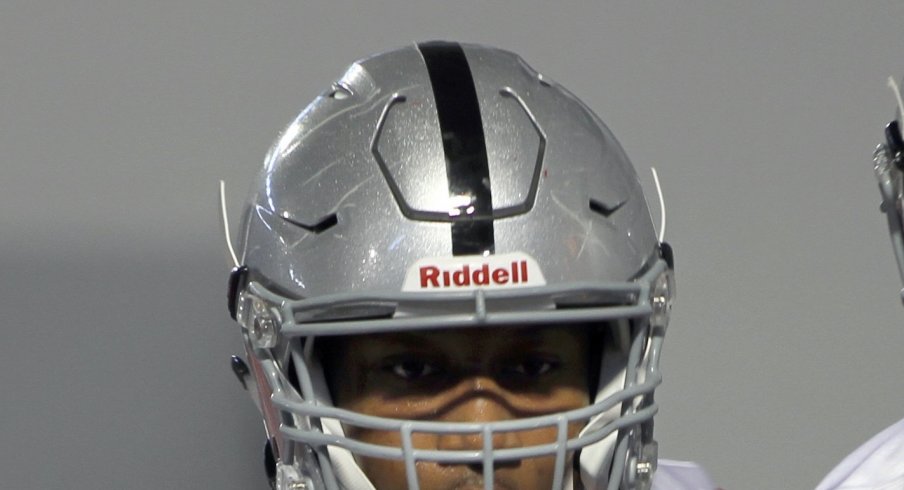The first mention of a "black stripe" that I can find on this site dates back to 2012.
Shortly after Urban Meyer became head coach, Ohio State fans noticed that incoming freshman had a very particular mark of Cain affixed to their helmets: a black stripe that transformed an iconic piece of head gear into an iconic piece of head gear with a black stripe on it.
When he got his first head coaching job at Bowling Green in 2001, Meyer started putting a stripe down the middle of the freshmen’s helmets. When they’re removed, they officially become a member of the team. The stripe program was instituted to help battle hazing. Some sort of initiation was still needed, though.
[...]
“It’s a rite of passage,” he said. Meyer said the ceremony for removing stripes even verges on emotional. “It feels like I’m a part of the team now,” Spence said. “But I have to keep working hard to show that I earned it.”
As Kyle Rowland's article from 2012 notes, there is no set criteria for when an Ohio State freshman finally gets their stripe removed, but as Ryan Day has continued the tradition, that hasn't lessened the impact that it has had one either the players or Ohio State's extremely cool and good media team, for instance.
Rites of passage in general are fascinating as hell.
The Mawé people of Brazil, for example, are famous for their tradition involving initiates wearing gloves filled with bullet ants, which are not named bullet ants because of their gentle nature and pleasant nibble. The Inuit on North Baffin island send their preteens alone out into the icy wilds with a "good luck kid, bring back a narwhal" and little else. And teenagers in the United States making less than minimum wage while working the 2 a.m. shift at Taco Bell discover the joys of poor corporate oversight allowing employers to ignore labor laws.
The thing about all of these rites of passage is that they suggest something not just about the culture that creates them, but also the people that help perpetuate them.
Black Stripe Alert
— Ohio State Football (@OhioStateFB) October 7, 2020
Only big things in store for @ParisJohnsonJr! Congrats on losing that black stripe!#GoBuckeyes pic.twitter.com/jA48Rccm7Q
The shedding of the black stripe is so incredibly and thoroughly "Urban" that if you had told me about the whole tradition and ceremony around it without telling me which coach had thought it up, Meyer would've been my second guess right behind like P.J. Fleck or somebody.
It's ceremony rooted in the idea of competition and accomplishment, but it's also one in which the rules are pretty arbitrary and to get to the mountaintop you have to reach an ultimately unknowable standard of respect based on work ethic, passion, and teamwork. It's also a clever way to ensure that those who haven't yet shed the stripe work their asses off, because there's no way to fall "behind" as long as you keep striving for recognition.
But that's an Urban Meyer/Ryan Day jam. When I was thinking about this topic, I remembered that back in the day Jim Tressel had his own coaching website, the appropriately named JimTressel.com, which I checked religiously during the football season because it had a Buckeye sticker tracker that kept tabs on who was kicking ass according to the coaching staff.
And while today we also have a pretty good idea of how coaches view players via postgame evaluations ("winning" performances and so on), in his own extremely Tresselian way, the Senator did the same thing with Buckeye leaves.

That's a screenshot from the Internet Archive's Wayback Machine, because as you might suspect, Tressel's website is no longer active. Which is a shame, really, because both the Buckeye leaves criteria and literally every other Web 1.5 thing on that site is a look into the kind of culture that Tressel sought to create via his own rites of passage and standards that he set forth in the mid-oughts.
Ryan Day isn't Urban Meyer and he isn't Jim Tressel, but the thing about culture is that it is constantly building upon itself. Day has a dash of ubercompetitiveness from Meyer, some of the analytical evaluation from Tressel, and who knows, maybe some of the weird capriciousness of Chip Kelly.
What I'm interested in seeing is what Ryan Day does to create a rite of passage or a set of team standards that are uniquely his, in part because as a member of the Columbus community he's already making a very specific and positive impact in a way that reflects his own personal story and also is something that Meyer and Tressel might not have done themselves.
My recommendation to Day? Be as weird as you wanna be, homie. The thing about rites of passage or any other kind of ritual is that their inherent weirdness can be tolerated as long as there's buy-in from the people participating in them. I have no idea why the hell anyone in their right mind, fans or players, would participate in quick cals (I'm not going to give it the dignity of capitalization), but damn, they totally do and have been for the better part of a decade now.
Offensive lineman Taylor Decker said the first thing he does after each practice is ask Meyer if he’s done enough to deserve a stripe removal.
“That’s a really big deal,” linebacker David Perkins said. “I take that so serious. That will be the first milestone for me. You’re not officially a Buckeye until that stripe comes off.”
As a student at Ohio State, I spent my freshman year terrified that my grades would tank as my professors eventually sussed out that I was in fact a very dumb man in a not quite as dumb man's suit. Aside from dutifully going to football games I didn't really partake in any of the traditional cool kid college stuff. But then, my sophomore year, Ohio State upset Michigan in the Horseshoe.
I stormed the field, tore up some of the turf, went to Wendy's, ate 20 dollars' worth of food, lost the turf in the bathroom, partied with my friends, crashed in my garbage lofted bed in a duplex on Summit at 3 a.m., and slept all Sunday.
I was finally a Buckeye.


